How Long Does Pepperoni Last in the Fridge
Your opened pepperoni's shelf life depends on how you store it. In the refrigerator, properly sealed sliced pepperoni stays fresh for up to three weeks, while unopened vacuum-sealed packages can last six weeks beyond their printed date. Whole cut pepperoni maintains quality for 4-5 weeks when tightly wrapped. You'll need to keep it at a desirable temperature between 35-40°F (1.7-4.4°C) in an airtight container to maximize freshness. Watch for signs of spoilage like color changes, odd odors, or slimy texture. For optimum safety and longevity, proper storage techniques and temperature control make all the difference in preserving your pepperoni's quality.
This post may contain affiliate links. If you make a purchase through these links, I may earn a commission at no additional cost to you. Additionally, portions of this post may be generated using artificial intelligence (AI) technology. While we strive for accuracy, please be aware that AI-generated content may not always be perfect and should be fact-checked when necessary.
The Spatula Scoops
- Unopened vacuum-sealed pepperoni lasts up to six weeks past the printed date when stored properly in the refrigerator.
- Opened sliced pepperoni packages remain good for up to three weeks when properly resealed and refrigerated.
- Whole cut pepperoni stays fresh for 4-5 weeks in the fridge when wrapped tightly to prevent air exposure.
- Maintain refrigerator temperature between 35-40°F (1.7-4.4°C) for optimal pepperoni preservation.
- Discard pepperoni immediately if you notice brown coloring, slimy texture, rancid odors, or any mold growth.
Types of Pepperoni Storage
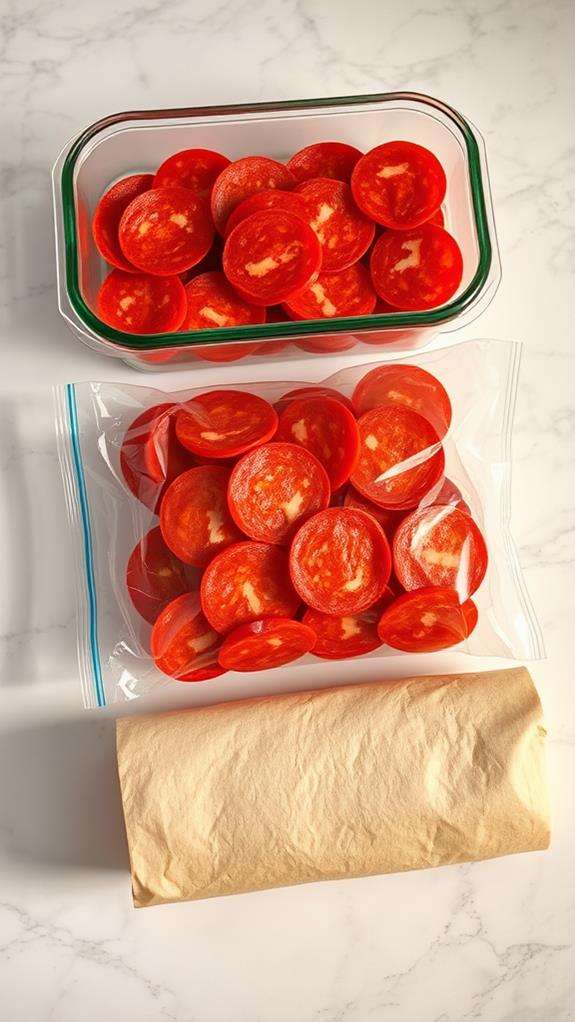
Every pepperoni package requires proper storage to maintain its quality and safety. You'll find three main storage options for your pepperoni: refrigeration, freezing, and pantry storage, each suited for different types and states of the product.
For unopened, shelf-stable pepperoni, you can keep it in your pantry at room temperature until the best-by date. Once you've opened the package, you'll need to transfer it to the refrigerator, where it's best stored in an airtight container or wrapped tightly in plastic wrap or aluminum foil. If you're dealing with fresh, uncured pepperoni, it must go straight to the fridge, even before opening.
Freezer storage offers the longest preservation method, and you'll want to double-wrap your pepperoni in freezer-safe materials to prevent freezer burn. For pre-sliced pepperoni, consider placing wax paper between layers before freezing to prevent sticking. If you're storing dry-cured pepperoni, you can hang it in a cool, dry place with proper ventilation, but you'll need to monitor humidity levels to prevent mold growth.
Refrigerator Storage Time Limits
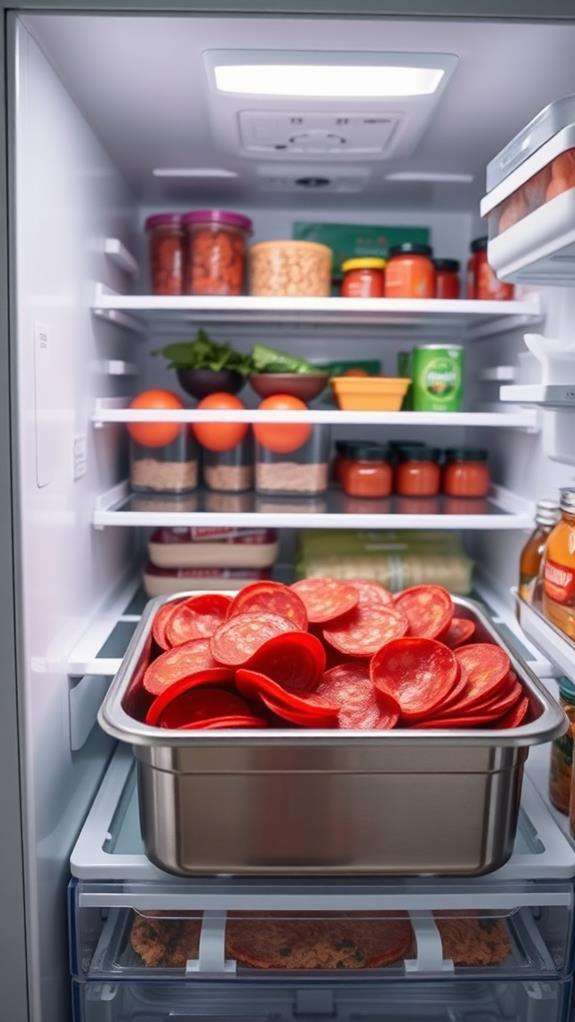
Proper timing is essential when storing pepperoni in your refrigerator. When you're dealing with unopened, vacuum-sealed packages, you can typically store them for up to six weeks past the printed date, provided you maintain a consistent temperature of 40°F (4°C) or below.
For opened packages of sliced pepperoni, you'll need to be more vigilant with timing. Once you've broken the original seal, you should consume the pepperoni within 3 weeks, assuming you've properly resealed it in an airtight container or zip-lock bag. If you're storing whole pepperoni sticks that have been cut, they'll last about 4-5 weeks when wrapped tightly in plastic wrap or butcher paper.
You'll want to check your pepperoni regularly for signs of spoilage, regardless of these timeframes. If you notice any changes in color (from red to brown or gray), unusual odors, or slimy texture, it's time to discard the product. For ideal freshness, store your pepperoni in the meat drawer of your refrigerator, where temperatures remain more stable and humidity levels are better controlled.
Signs of Spoiled Pepperoni

When checking your pepperoni for spoilage, you'll need to watch for three key warning signs. Changes in color, such as brown, gray, or greenish patches on the meat's surface, along with an unpleasant sour or rancid odor, indicate that your pepperoni has gone bad. If you notice a slimy or sticky film developing on the surface when you touch the pepperoni, it's definitely time to toss it out, as these textures are clear indicators of bacterial growth.
Off-Color or Discoloration
Pepperoni's natural red color serves as a key indicator of its freshness. When examining your pepperoni, you'll want to look for consistent coloring throughout the meat, which typically appears as a deep red or reddish-brown shade due to the curing process and spice mixture.
If you notice your pepperoni developing brown, gray, or greenish patches, it's likely starting to spoil. These discolored areas often begin at the edges and can gradually spread across the surface. You'll want to pay special attention to any spots that appear darker than the surrounding meat, as this can indicate the growth of bacteria or mold colonies. White or grayish fuzzy patches are particularly concerning, as they're clear signs of mold development.
Sometimes, you might notice a white powdery substance on the outside of your pepperoni. Don't confuse this with mold – it's often just harmless salt crystallization from the curing process. However, if this white coating appears slimy or has an iridescent sheen, you should discard the pepperoni immediately. You'll also want to check for any unusual dark spots or rainbow-like discoloration on the meat's surface, as these can indicate chemical changes due to oxidation.
Unpleasant Smell
Beyond visual cues, your nose can be one of the most reliable tools for detecting spoiled pepperoni. Fresh pepperoni should have a distinct, spicy-sweet aroma with notes of paprika, garlic, and cured meat. If you notice any off-putting odors, it's time to investigate further.
When pepperoni starts to spoil, you'll detect several concerning smells. A sour or fermented odor is often the first warning sign, indicating that bacteria have begun breaking down the meat's proteins. You might also notice a rancid smell, which occurs when the fats in the pepperoni have oxidized. If there's an ammonia-like or putrid scent, that's a clear indication that the meat has completely spoiled and shouldn't be consumed. Even if only a small portion of your pepperoni smells off, you shouldn't risk eating any of it, as harmful bacteria may have spread throughout the entire piece. Trust your instincts – if something doesn't smell right, it's better to err on the side of caution and discard the pepperoni rather than risk food poisoning.
Slimy or Sticky Texture
Running your fingers across the surface of pepperoni can reveal essential signs of spoilage. When you're examining your pepperoni, pay attention to any unusual coating or texture that doesn't feel quite right. Fresh pepperoni should have a firm, slightly dry surface that's pleasant to touch, while spoiled pepperoni will often develop an unpleasant, slimy film.
If you notice that your pepperoni feels sticky or has a coating that seems unusually wet or greasy, it's likely that bacteria have begun breaking down the meat's surface proteins. This bacterial activity creates a biofilm, which manifests as that characteristic sliminess you're feeling. Don't try to wash or wipe off this layer – it's a clear indication that the pepperoni has gone bad. You might also notice that the texture feels tacky or that your fingers slightly stick to the meat's surface when you touch it. This change in texture often appears before visible mold develops, making it an early warning sign of spoilage. When you encounter any of these texture changes, it's best to err on the side of caution and discard the pepperoni to avoid potential foodborne illness.
Best Storage Practices
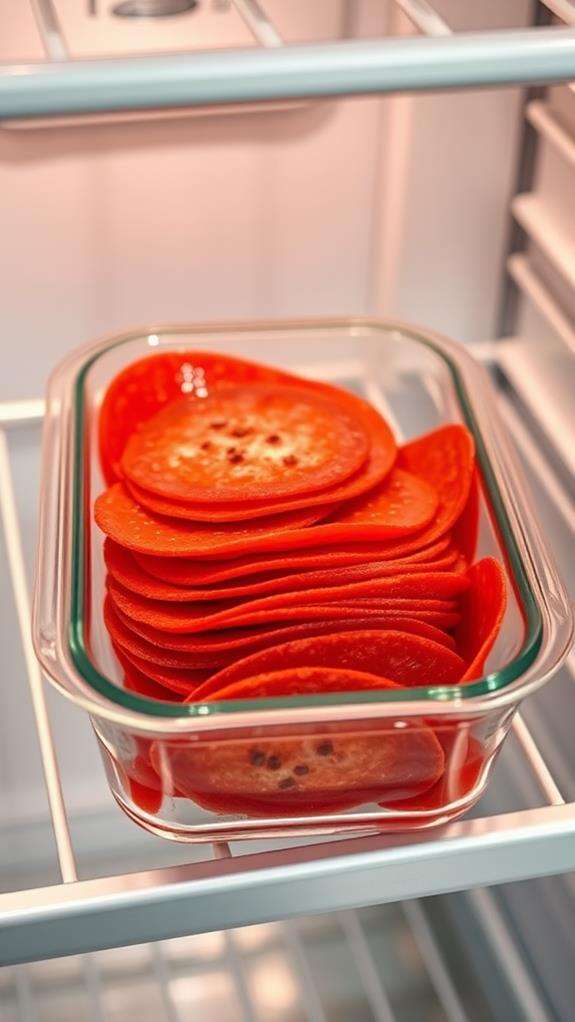
Proper storage practices make all the difference in extending pepperoni's shelf life. You'll want to keep your pepperoni in an airtight container or sealed plastic bag, removing as much air as possible before storing it in your refrigerator. If you've purchased pre-packaged pepperoni, it's best to keep it in its original packaging until you're ready to use it.
Here's a quick reference guide for ideal storage conditions:
| Storage Method | Temperature | Max Storage Time |
|---|---|---|
| Original Package | 40°F (4°C) | 6 weeks |
| Airtight Container | 40°F (4°C) | 3 weeks |
| Vacuum Sealed | 40°F (4°C) | 8 weeks |
Once you've opened your pepperoni, you shouldn't leave it at room temperature for more than two hours. If you don't plan to use it within three weeks, consider freezing it. When freezing, wrap the pepperoni tightly in freezer paper or heavy-duty aluminum foil, then place it in a freezer bag. You'll also want to write the storage date on the package to track its freshness.
Extending Pepperoni Shelf Life

To extend your pepperoni's shelf life, you'll need to focus on maintaining consistent, proper storage methods that keep your meat at or below 40°F (4°C). You can protect the quality of your pepperoni by storing it in airtight containers or resealable plastic bags, removing as much air as possible before sealing to prevent oxidation and bacterial growth. Regularly monitoring your refrigerator's temperature settings with a reliable thermometer will help guarantee your pepperoni stays fresh for the maximum possible duration, as temperature fluctuations can greatly impact its longevity.
Proper Storage Methods
Keeping your pepperoni fresh depends heavily on how you store it. To maximize its shelf life, you'll need to create an environment that minimizes exposure to heat, moisture, and bacteria. The key is maintaining proper temperature control and using appropriate packaging materials.
For unopened pepperoni, you should keep it in its original packaging until you're ready to use it. Once you've opened the package, wrap the remaining pepperoni tightly in plastic wrap or aluminum foil, then place it in an airtight container or resealable plastic bag. Make sure to squeeze out as much air as possible to prevent oxidation, which can lead to spoilage.
Store your wrapped pepperoni in the refrigerator's meat drawer, where the temperature remains consistent between 35-40°F (1.7-4.4°C). If you're storing sliced pepperoni, place wax paper between layers to prevent them from sticking together. For pre-sliced packages, use a zip-top bag with a paper towel inside to absorb excess moisture. Don't store pepperoni near strong-smelling foods, as it can absorb odors. Check the storage container regularly for any condensation, which could indicate improper sealing.
Monitor Temperature Settings
Temperature control plays a critical role in extending your pepperoni's shelf life. You'll need to maintain your refrigerator at the ideal temperature range of 35-40°F (1.6-4.4°C) to prevent bacterial growth while preserving the meat's quality. It's important to regularly check your fridge's temperature using a reliable thermometer, as built-in displays aren't always accurate.
To guarantee proper temperature management for your pepperoni storage, follow these key guidelines:
- Place your pepperoni in the main compartment of your fridge, not the door, where temperatures fluctuate more frequently due to opening and closing
- Store unopened packages in the coldest part of your refrigerator, typically the back of the bottom shelf
- Use an additional food thermometer near your pepperoni's storage location to monitor local temperature variations
Don't forget to check your refrigerator's seal integrity, as a compromised door gasket can lead to temperature inconsistencies. If you notice temperature fluctuations above 40°F, adjust your fridge's settings immediately. Remember that modern refrigerators often have different cooling zones, so you'll want to identify and utilize the most consistently cool areas for your pepperoni storage.
Temperature Control Guidelines
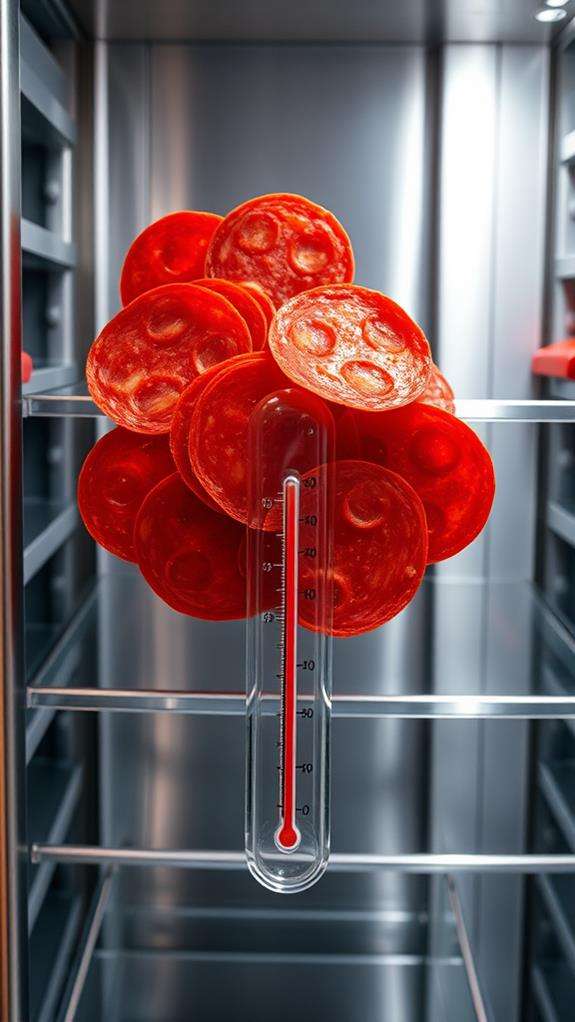
Proper storage temperature plays a critical role in keeping your pepperoni fresh and safe to eat. You'll want to maintain your refrigerator's temperature between 35°F and 40°F (1.6°C to 4.4°C), with 37°F (2.8°C) being the ideal target. Cold items, like pepperoni, should not remain at room temperature for more than a couple of hours, as proper handling techniques reduce the risk of spoilage and bacterial growth. Don't let the temperature fluctuate above these ranges, as this can promote bacterial growth and spoilage.
To guarantee you're following proper temperature control guidelines, you'll need to place your pepperoni in the main compartment of your fridge, not in the door where temperatures tend to vary. If you've opened the package, store it in an airtight container or resealable plastic bag to prevent exposure to varying temperatures and humidity levels. For unopened packages, you can keep them in their original packaging, but you should still monitor the surrounding temperature carefully. Consider using a refrigerator thermometer to check the temperature regularly, as your fridge's built-in settings might not always be accurate. If you notice temperature fluctuations, adjust your refrigerator's settings immediately to maintain ideal storage conditions for your pepperoni.
Freezing Pepperoni
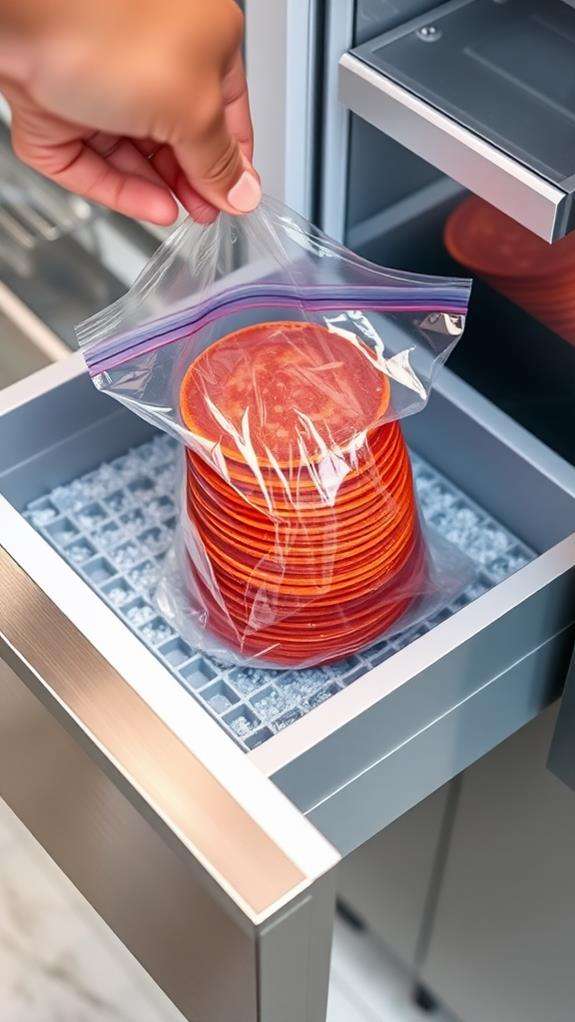
Freezer storage offers an excellent way to extend your pepperoni's shelf life beyond standard refrigeration. When properly frozen at 0°F (-18°C), your pepperoni can last up to 6 months while maintaining its quality and flavor profile. You'll want to wrap your pepperoni tightly in freezer-safe materials to prevent freezer burn and protect against moisture loss.
To guarantee the best outcomes when freezing pepperoni, follow these essential steps:
- Double-wrap your pepperoni in plastic wrap or aluminum foil, then place it in a freezer-safe bag with the air pressed out
- Label your package with the freezing date and contents using a permanent marker
- Store the pepperoni in the back of your freezer where temperatures remain most consistent
When you're ready to use your frozen pepperoni, transfer it to your refrigerator and allow it to thaw gradually for 24-48 hours. Don't try to speed up the process by thawing at room temperature, as this can promote bacterial growth. Once thawed, you should use the pepperoni within 7-10 days for prime quality, and never refreeze previously frozen pepperoni, as this can compromise both texture and food safety.
Health and Safety Considerations
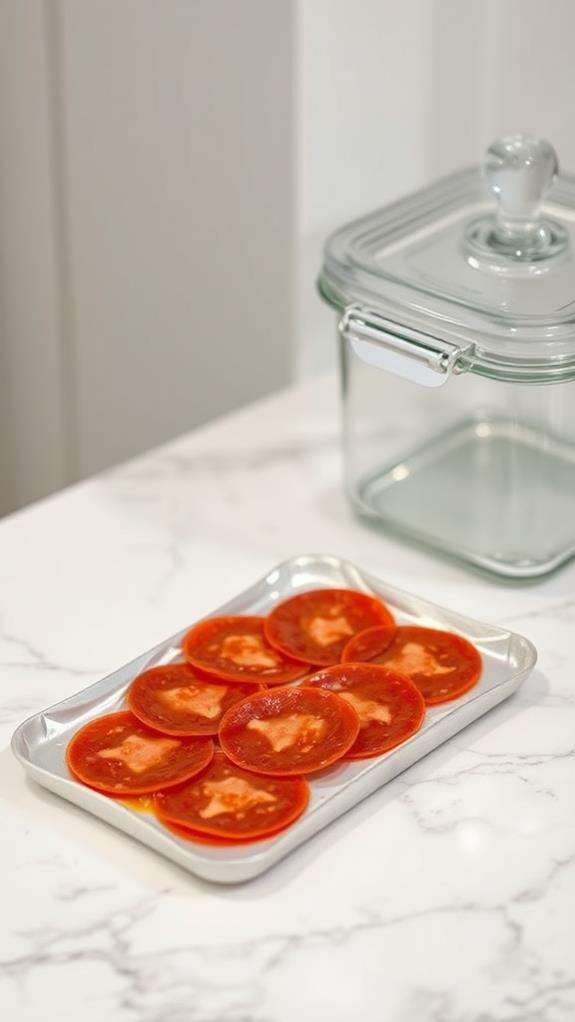
Food safety stands as the most critical aspect of storing and consuming pepperoni. You'll need to watch for signs of spoilage, which include discoloration, off-putting odors, or any visible mold growth. If you notice a slimy texture or unusual spots on your pepperoni, it's time to discard it immediately.
| Warning Sign | Action Required | Risk Level |
|---|---|---|
| Mold Growth | Discard Immediately | High |
| Sour Smell | Don't Consume | High |
| Color Changes | Inspect Carefully | Medium |
When handling pepperoni, you should always follow proper food safety protocols. Keep your hands clean, use separate cutting boards for meats and other foods, and maintain your refrigerator's temperature at or below 40°F (4°C). Cross-contamination poses a significant risk, so you'll want to store your pepperoni in airtight containers or sealed plastic bags.
Remember that consuming spoiled pepperoni can lead to foodborne illness, with symptoms including nausea, vomiting, and diarrhea. If you're unsure about the safety of your pepperoni, it's better to err on the side of caution and dispose of it rather than risk getting sick.
Package Dating and Labels
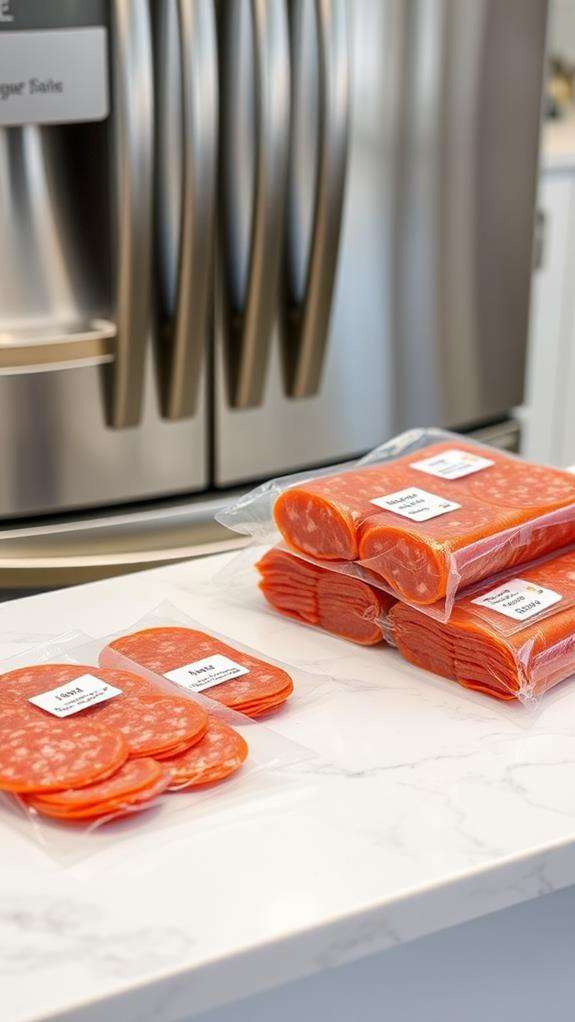
When checking pepperoni packaging, you'll come across various types of dates and labels that help determine freshness. Understanding these labels is essential for food safety and ideal consumption. You'll typically find either a "Best By," "Use By," or "Sell By" date prominently displayed on the package.
Here's what each common date label means:
- "Best By" dates indicate when the pepperoni will be at its peak quality, though it's often safe to consume for several days beyond this date if properly stored.
- "Use By" dates are stricter guidelines that you shouldn't ignore, as they relate directly to food safety rather than just quality.
- "Sell By" dates are primarily for retailers' inventory management, but they'll give you about 3-5 days of ideal storage time after purchase.
You should also check for lot numbers and manufacturing codes, which manufacturers use for tracking purposes. While these might look like random numbers and letters, they're valuable for identifying specific production batches. If there's ever a recall, you'll need these codes to determine if your pepperoni is affected. Always keep the original packaging until you've consumed all the product.
Frequently Asked Questions
Can Pregnant Women Safely Eat Refrigerated Pepperoni?
You should exercise caution with pepperoni during pregnancy, as it's a deli meat that can harbor Listeria bacteria. While refrigeration slows bacterial growth, it doesn't eliminate all risks. If you're craving pepperoni, make sure to heat it until steaming hot (165°F) to kill potential bacteria. Many doctors recommend avoiding cold pepperoni entirely during pregnancy. When in doubt, consult your healthcare provider about your specific situation.
Does Pepperoni Continue to Cure and Get Spicier in the Fridge?
As cold as a winter's day, your fridge actually slows down the curing process of pepperoni to a crawl. You won't notice your pepperoni getting spicier over time since the cool temperature inhibits the fermentation and aging processes that affect flavor development. While the salt and spices are already fully incorporated during manufacturing, they'll maintain their current level of heat rather than intensifying in your refrigerator.
Should Pepperoni Be Stored With Other Cured Meats?
You can store pepperoni with other cured meats, but you'll want to take some precautions. Keep each type of meat in its own sealed container or bag to prevent cross-contamination of flavors and bacteria. While they're all cured, different meats can have varying cure levels and moisture content. It's best to wrap your pepperoni separately in wax paper or plastic wrap before storing it with other cured meats.
Can I Use Slightly Discolored Pepperoni in Cooked Dishes?
Like Dorian Gray's portrait, discolored pepperoni serves as a warning sign you shouldn't ignore. You shouldn't use pepperoni that's showing signs of discoloration, even in cooked dishes. While cooking kills some bacteria, it won't eliminate toxins that may have already formed. For your safety, it's best to discard any pepperoni that's changed color, developed dark or gray spots, or shows signs of mold.
Will Storing Pepperoni Near Strong-Smelling Foods Affect Its Taste?
Yes, you'll want to be careful about storing pepperoni near strong-smelling foods, as it can absorb other odors through a process called cross-contamination of aromas. Since pepperoni's fats readily absorb nearby scents, you should keep it away from foods like onions, garlic, or strong cheeses. For best results, store your pepperoni in an airtight container or sealed plastic bag to protect its distinctive flavor and prevent it from picking up unwanted tastes.





